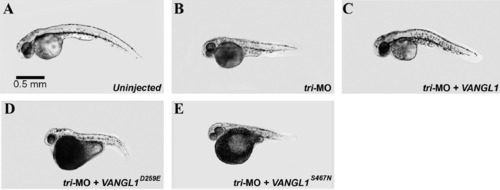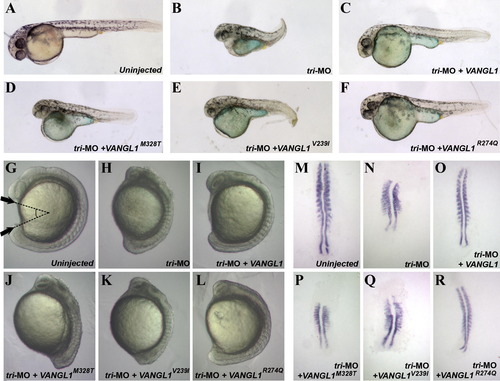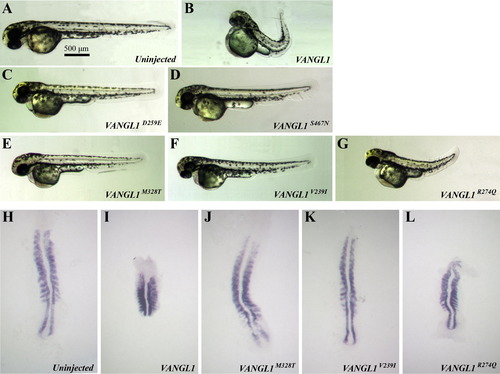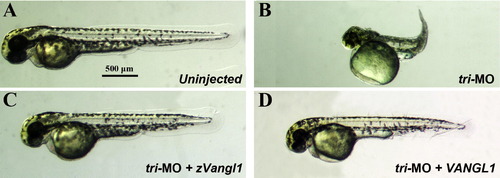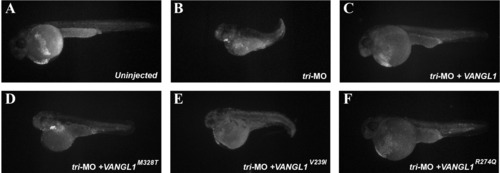- Title
-
VANGL1 rare variants associated with neural tube defects affect convergent extension in zebrafish
- Authors
- Reynolds, A., McDearmid, J.R., Lachance, S., Marco, P.D., Merello, E., Capra, V., Gros, P., Drapeau, P., and Kibar, Z.
- Source
- Full text @ Mech. Dev.
|
Activity of mouse Looptail VANGL1 mutant RNAs in zebrafish lacking tri. Panels A–E show lateral views of zebrafish at 2 days post fertilization. In Panel A, an uninjected wild-type fish is shown. In Panel B, a fish injected with tri-MO alone show a marked shortening of the trunk. In Panel C, VANGL1 RNA partially rescued the trunk phenotype induced by co-injection of tri-MO. Co-injection of VANGL1D259E (Panel D) or VANGL1S467N (Panel E) with tri-MO did not rescue the reduced body length phenotype induced by tri-MO. EXPRESSION / LABELING:
PHENOTYPE:
|
|
Ability of human VANGL1 RNA variants to rescue the convergent extension defect in zebrafish embryos treated with tri-MO. Panels A–F show lateral views of zebrafish at approximately 2 days post fertilization. In Panel A, an uninjected wild-type fish is shown. In Panel B, a fish injected with tri-MO alone show a marked shortening of the trunk. In Panel C, VANGL1 RNA partially rescued the trunk phenotype induced by co-injection of tri-MO. VANGL1M328T (Panel D) and VANGL1V239I (Panel E) RNA injection failed to compensate for the phenotype induced by co-injection of tri-MO. In Panel F, VANGL1R274Q RNA partially rescued the tri-MO induced phenotype. Panels G–L show 10–12 somites embryos, with the arrows pointing at the tip of the head and the end of the tail. The angle formed by the arrows and indicated by dotted lines was measured to assess the extension defects in zebrafish lacking tri. Injection of tri-MO (Panel H) caused a significant increase in body angle. This defect was partially rescued by co-injection of tri-MO with VANGL1 (Panel I) or VANGLR274Q (Panel L). In contrast, tri-MO + VANGL1M328T (Panel J) or tri-MO + VANGL1V239I (Panel K) failed to induce a recovery in extension processes and caused the body angle to remain larger. Panels M–R show dorsal views of 8–14 somites zebrafish embryos stained with MyoD. In Panel M, the converged and extended somites of a wild-type embryo are shown. In Panel N, zebrafish injected with tri-MO alone exhibit wider somites lining the open neural tube. In Panel O, VANGL1 RNA co-injected with tri-MO rescues neural tube closure and convergent extension. However, VANGL1M382T (Panel P) or VANGL1V239I (Panel Q) RNA injection fail to rescue the tri phenotype while VANGLR274Q RNA injection (Panel R) compensates for the phenotype. PHENOTYPE:
|
|
Effect of overexpression of human VANGL1 variants on convergent extension in zebrafish embryos. Panels A–F show lateral views of 2 days post fertilization zebrafish. In Panel A, an uninjected wild-type fish is shown. In Panel B, a fish injected with high doses of VANGL1 alone show a severely reduced body length. Overexpression of either VANGL1D259E (Panel C) or VANGL1S467N (Panel D) or VANGL1M 328T (Panel E) or VANGL1V239I (Panel F) did not affect the body length in zebrafish embryos. In Panel G, VANGL1R274Q RNA behaved like the wild-type VANGL1 (Panel B) and caused a severe reduction in body length when overexpressed. Panels H–L show dorsal views of 8–14 somites zebrafish embryos stained with MyoD. In Panel H, the converged and extended somites of an uninjected wild-type fish are shown. Overexpression of VANGL1 (Panel I) or VANGLR274Q (Panel L) RNA caused wider somites lining the open neural tube, while overexpression of either VANGL1M382T (Panel J) or VANGL1V239I (Panel K) RNA did not affect this phenotype. |
|
Ability of human VANGL1 to rescue the convergent extension defect in tri-MO zebrafish. Panels A-D show lateral views of zebrafish at 2 days post fertilization. In Panel A, an uninjected wild-type fish is shown. In Panel B, a fish injected with tri-MO alone shows a marked shortening of the trunk. In Panel C, 10-25 pg of zebrafish Vangl1 (zVangl1) RNA partially rescued the trunk phenotype induced by co-injection of tri-MO. Co-injection of human VANGL1 (panel D) did rescue the tri-MO induced body length phenotype but at higher doses (50-150 pg). |
|
Little apoptosis in zebrafish lacking tri. Apoptosis was assessed by visualizing acridine orange labeled cells. In wild-type larvae, the majority of dying cells were observed in the yolk (Panel A). In tri-MO injected embryos, there were slightly more labeled cells in the body and the yolk of the larvae (Panels B–F). |
Reprinted from Mechanisms of Development, 127(7-8), Reynolds, A., McDearmid, J.R., Lachance, S., Marco, P.D., Merello, E., Capra, V., Gros, P., Drapeau, P., and Kibar, Z., VANGL1 rare variants associated with neural tube defects affect convergent extension in zebrafish, 385-392, Copyright (2010) with permission from Elsevier. Full text @ Mech. Dev.

